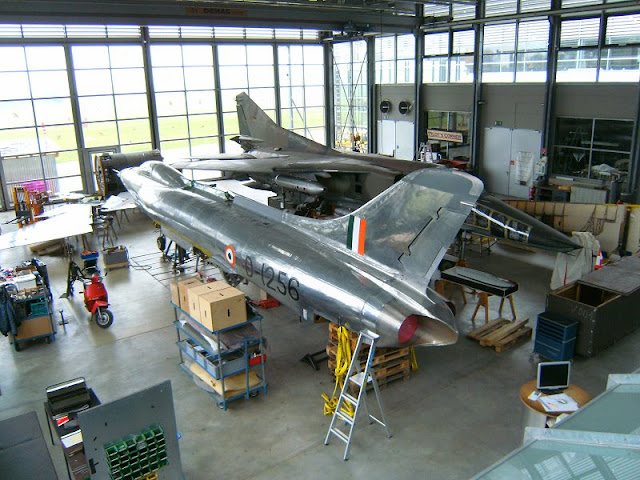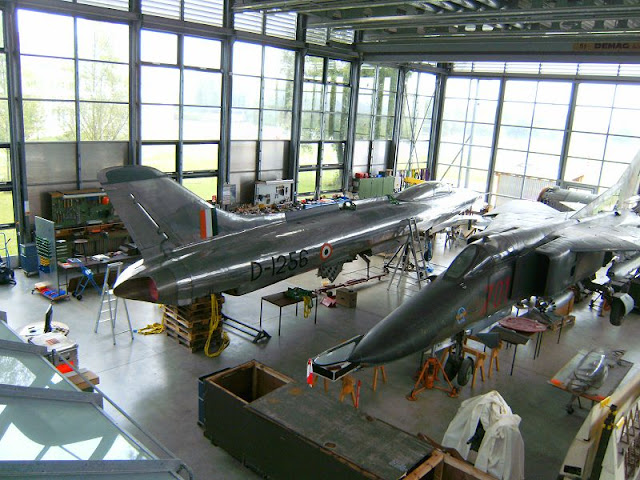Copyright by Happyscale Modellbau. Vervielfältigung (Druck oder digital) nur mit schriftlicher Genehmigung des Urhebers.
Copyright by Happyscale Modellbau. Duplication (print or digital) only with written agreement from author.
The Hindustan Aeronautics HF-24 Marut (Sanskrit: मरुत्, for "Spirit of the Tempest") was an Indian fighter-bomber aircraft of the 1960s. It was India's first jet aircraft, took first flight on 17 June 1961.
The Marut was used in combat in the ground attack role, where its
safety features such as manual controls whenever the hydraulic systems
failed and twin engines increased survivability. All Maruts were retired
from IAF service in 1990.
In 1967, one Marut was used as a testbed for the Egyptian Brandner E-300 engine.
Given the limited number of Marut units, most Marut squadrons were
considerably over-strength for the duration of their lives. According to
Brian de Magray, at peak strength No.10 Squadron had on charge 32
Maruts, although the squadron probably did not hold a unit-establishment
of more than 16. The Marut squadrons participated in the 1971 war and
none was lost in air-to-air combat, although four were lost to ground
fire and two were destroyed on the ground. Three Marut pilots were
awarded the Vir Chakra commendation.
Maruts constantly found themselves under heavy and concentrated fire
from the ground during their low-level attack missions. On at least
three occasions, Maruts regained their base after one engine had been
lost to ground fire. On one of these, a Marut returned to base without
escort on one engine, from about 150 miles (240 km) inside hostile
territory. On another occasion, a pilot flying his Marut through debris
that erupted into the air as he strafed a convoy felt a heavy blow in
the rear fuselage of the aircraft, the engine damage warning lights
immediately glowing and one engine cutting out. Fortunately, the Marut
attained a safe and reasonable recovery speed on one engine.
Consequently, the pilot had no difficulty in flying his crippled fighter
back to base. Another safety factor was the automatic reversion to
manual control in the event of a failure in the hydraulic flying control
system, and there were several instances of Maruts being flown back
from a sortie manually. The Marut had good survivability record in enemy
airspace.
In the Indo-Pakistani War of 1971, some Maruts and Hawker Hunter aircraft were used to give close support to an Indian border post in the decisive Battle of Longewala, on the morning of 5 December 1971.
One aerial kill recorded by Marut flown by Sqn Ldr KK Bakshi of 220
Squadron shot down a PAF F-86 Sabre on 7 Dec 71 (Flg Offr Hamid Khwaja
of 15 Squadron PAF).
From Wikipedia, the free encyclopedia HAL HF-24 Marut
- fotografiert im Deutschen Museum Oberschleißheim von Bianca Krop-Kaiser & Alexander Krop
Seiten
- Startseite
- Impressum
- Flugzeuge / aircraft
- Dioramen / dioramas
- Schiffe / ships
- Militärfahrzeuge / Military Vehicles
- Waffen / weapon
- Cars - Autos / Trucks - LKW's
- Buildings / Gebäude
- Raumfahrt / astronautics
- Science Fiction
- Figuren
- Ausstellungen / Exhibitions
- Originale / originals (foto-stream)
- Downloads
- Wallpaper
- Spiele
- sonstige Basteleien
- Tools
- Aviation Art / Luftfahrtbilder
- Datenschutzerklärung
Abonnieren
Kommentare zum Post (Atom)






Keine Kommentare:
Kommentar veröffentlichen